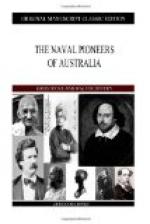The Roebuck struck soundings on the night of August 1st, 1699, upon the northern part of the Abrolhos. Dampier then cautiously ran northward, keeping the land in sight until he anchored in Dirk Hartog’s Road, in a sound which he named Sharks’ Bay, for the reason that his men caught and ate, among other things, many sharks, including one eleven feet long, and says Dampier, “Our men eat them very savorilly.” He gives us, too, a description of the kangaroo, the first introduction of that animal to civilization. Says the navigator, “The land animals that we saw here were only a sort of racoons, different from those of the West Indies, chiefly as to their legs; for these have very short fore legs, but go jumping upon them as the others do, and, like them, are very good meat.”
Sharks’ Bay is in what is now called the Gascoyne division of West Australia, after the river of that name. Its chief town is Carnarvon, situated at the mouth of the river. Wool-growing [Sidenote: 1699] is the principal industry, and the population is about 800.
[Illustration: CAPTAIN WILLIAM DAMPIER, R.N. From the picture in the National Portrait Gallery painted by Thomas Murray.] To face p. 38.
Dampier stayed eight days in the bay, then ran northward along the coast, discovering the archipelago named after him, and himself naming Rosemary Island, which lies off the coast close to Roeburne, the chief town of the north province of the colony. From here he continued his course north till he reached Roebuck Bay, a few leagues to the south of the scene of his first visit, and where is now the town of Broome. The Eastern Extension Telegraph Cable Company’s alternative cable from Banjoewangi comes in here, and the town has additional importance as being the harbour for a large pearling fleet.




